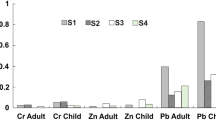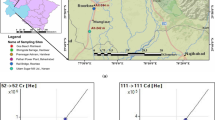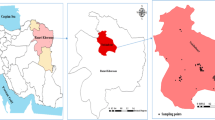Abstract
Heavy metal contamination in drinking water is a global health concern. Anthropogenic and geogenic activities exacerbate the concentrations of these metals in surface and groundwater. In this study, we sampled drinking water sourced from surface and groundwater resources at the environs of Mrima Hill and the Kwale heavy minerals sand deposit, Kwale County, Kenya. The concentrations of Cr, Ni, Cu, As, Cd, Pb, and U were measured using the inductively coupled plasma mass spectrometer. The water quality indices were evaluated using the weighted arithmetic index method, while the human health risks due to exposure to these heavy metals through the ingestion pathway were assessed using deterministic and probabilistic techniques. The concentrations of Cr and Cd in samples from both study areas exceeded the national and international maximum contaminant levels in drinking water. The concentration levels of Ni, Cu, As, and U in all samples from both study areas were within the recommended values in drinking water. Therefore, the quality of water from both study areas was unsuitable for human consumption due to Cd and Cr contamination. The non-carcinogenic risk assessment also showed that the hazard indices (HI) evaluated for both children and adults at the study areas were higher than unity. In addition, the estimated carcinogenic risks of both population groups were more than the recommended value of 10–4. This study shows that the residents near Mrima Hill and the Kwale heavy minerals sand deposit remain susceptible to carcinogenic and non-carcinogenic health risks emanating from exposure to these heavy metals in drinking water.





Similar content being viewed by others
Availability of data and material
The datasets generated and/or analysed during the current study are not publicly available since this is part of an on-going doctoral research but are available from the corresponding author on request. Applicable data have been submitted as supplementary data to the manuscript.
Code availability
The Monte Carlo simulation used was based on EnviroPRA package in R-environment (Barrio-parra & Dominguez-Castillo, 2017). The specific modifications are not publicly available since this if part of an on-going doctoral research but may be made available from the corresponding author upon reasonable request.
References
Alarcón-Herrera, M. T., Bundschuh, J., Nath, B., Nicolli, H. B., Gutierrez, M., Reyes-Gomez, V. M., et al. (2013). Co-occurrence of arsenic and fluoride in groundwater of semi-arid regions in Latin America: Genesis, mobility and remediation. Journal of Hazardous Materials, 262, 960–969. https://doi.org/10.1016/j.jhazmat.2012.08.005
Alidadi, H., Belin, S., Sany, T., Zarif, B., Oftadeh, G., & Mohamad, T. (2019). Health risk assessments of arsenic and toxic heavy metal exposure in drinking water in northeast Iran. Environmental Health and Preventive Medicine, 24(59), 1–17.
Aoshima, K. (2016). Itai-itai disease: Renal tubular osteomalacia induced by environmental exposure to cadmium—historical review and perspectives. Soil Science and Plant Nutrition, 62(4), 319–326. https://doi.org/10.1080/00380768.2016.1159116
Bajwa, B. S., Kumar, S., Singh, S., Sahoo, S. K., & Tripathi, R. M. (2017). Uranium and other heavy toxic elements distribution in the drinking water samples of SW-Punjab, India. Journal of Radiation Research and Applied Sciences, 10, 13–19. https://doi.org/10.1016/j.jrras.2015.01.002
Banning, A., & Benfer, M. (2017). Drinking water uranium and potential health effects in the german federal state of Bavaria. International Journal of Environmental Research and Public Health, 14(8). https://doi.org/10.3390/ijerph14080927
Barrio-parra, F., & Dominguez-Castillo, A. (2017). EniroPRA:Envirommental Probabilisitc Risk Assessment Tools. https://cran.r-project.org/package=%0AEnviroPRA
Becquer, T., Quantin, C., Sicot, M., & Boudot, J. P. (2003). Chromium availability in ultramafic soils from New Caledonia. The Science of the Total Environment, 301, 251–261.
Caswell, P. V., & Baker, B. H. (1953). Geology of Mombasa-Kwale area. Report No.24, Ministry of Environment and Natural Resources, Mines and Geological department, Nairobi, Kenya.
Edmunds, W. M., & Smedley, P. L. (1996). Groundwater geochemistry and health: An overview. Geological Society Special Publication, 113, 91–105. https://doi.org/10.1144/GSL.SP.1996.113.01.08
Ertani, A., Mietto, A., & Borin, M. (2017). Chromium in Agricultural Soils and Crops : A Review. Water, Air, and Soil Pollution, 223(190), 1–12. https://doi.org/10.1007/s11270-017-3356-y
Fendorf, S., Michael, H. A., & Van Geen, A. (2010). Spatial and temporal variations of groundwater arsenic in South and Southeast Asia. Science, 328(5982), 1123–1127. https://doi.org/10.1126/science.1172974
Fernley, M., & Drolia, V. (2011). African Mineral: Metals and Minerals. GMP Securities Europe LLP.
Gibson, J. M., Fisher, M., Clonch, A., Macdonald, J. M., Cook, P. J. (2020). Children drinking private well water have higher blood lead than those with city water PNAS 1–10 https://doi.org/10.1073/pnas.2002729117
Goher, M. E., Hassan, A. M., Abdel-moniem, I. A., Fahmy, A. H., & El-sayed, S. M. (2014). Evaluation of surface water quality and heavy metal indices of Ismailia Canal, Nile River. Egypt. the Egyptian Journal of Aquatic Research, 40(3), 225–233. https://doi.org/10.1016/j.ejar.2014.09.001
Guo, H., Zhou, Y., Jia, Y., Tang, X., Li, X., Shen, M., et al. (2016). Sulfur cycling-related biogeochemical processes of arsenicmobilization in the western hetao basin, China: Evidence from multiple isotope approaches. Environmental Science and Technology, 50(23), 12650–12659. https://doi.org/10.1021/acs.est.6b03460
Hao, W., Kashiwabara, T., Jin, R., Takahashi, Y., Gingras, M., Alessi, D. S., & Konhauser, K. O. (2020). Clay minerals as a source of cadmium to estuaries. Scientific Reports, 10(1), 1–11. https://doi.org/10.1038/s41598-020-67279-w
Harb, S., Zahran, A. M., Abbady, A., & Ahmed, F. A. (2014). Assessment of Natural Radioactivity in Soil and Water Samples from Aden Governorate South Of Yemen Region. International Journal of Recent Research in Physics and Chemical Sciences, 1(1), 1–7.
Harmer, R. E., & Nex, P. A. M. (2016). Rare Earth Deposits of Africa. Episodes, 39(2), 381–406. https://doi.org/10.18814/epiiugs/2016/v39i2/95784
Harvey, P. J., Handley, H. K., & Taylor, M. P. (2016). Widespread copper and lead contamination of household drinking water, New South Wales, Australia. Environmental Research, 151, 275–285. https://doi.org/10.1016/j.envres.2016.07.041
Hassan, N. M., Rasmussen, P. E., Dabek-zlotorzynska, E., Celo, V., & Chen, H. (2007). Analysis of Environmental Samples Using Microwave- Assisted Acid Digestion and Inductively Coupled Plasma Mass Spectrometry : Maximizing Total Element Recoveries. Water, Air, and Soil Pollution, 178, 323–334. https://doi.org/10.1007/s11270-006-9201-3
Horkel, A. D., Neubauer, W., Niedermayer, G., Okelo, R. E., Wachira, J. K., & Werneck, W. (1984). Notes on the Geology and Mineral Resources of the Southern Kenyan Coast. Mitteilungen der Österreichischen Geologischen Gesellschaft, 77, 151–159. http://www2.uibk.ac.at/downloads/oegg/Band_77_151_159.pdf
Izbicki, J. A., Wright, M. T., Seymour, W. A., Mccleskey, R. B., Fram, M. S., Belitz, K., & Esser, B. K. (2015). Applied Geochemistry Cr ( VI ) occurrence and geochemistry in water from public-supply wells in California. Applied Geochemistry, 63, 203–217. https://doi.org/10.1016/j.apgeochem.2015.08.007
JICA. (1991). Report on the mineral exploration in Mombasa Area Republic of Kenya (Phase I).
Jurgens, B. C., Parkhurst, D. L., & Belitz, K. (2019). Assessing the Lead Solubility Potential of Untreated Groundwater of the United States. Environmental Science and Technology, 53, 3095–3103. https://doi.org/10.1021/acs.est.8b04475
Kadar, A., Noël, L., Chekri, R., Vastel, C., Millour, S., & Guérin, T. (2011). Optimisation of ICP-MS collision / reaction cell conditions for the determination of elements likely to be interfered ( V, Cr, Fe Co, Ni, As and Se ) in foodstuffs. Talanta, 85(5), 2605–2613. https://doi.org/10.1016/j.talanta.2011.08.027
Kaniu, M. I., Angeyo, H. K., Darby, I. G., & Muia, L. M. (2018). Rapid in-situ radiometric assessment of the Mrima-Kiruku high background radiation anomaly complex of Kenya. Journal of Environmental Radioactivity, 188, 47–57. https://doi.org/10.1016/j.jenvrad.2017.10.014
Kebwaro, J. M., Rathore, I. V. S., Hashim, N. O., & Mustapha, a. O. (2011). Radiometric assessment of natural radioactivity levels around Mrima Hill. Kenya. International Journal of Physical Sciences, 6(13), 3105–3110. https://doi.org/10.5897/IJPS11.052
Kim, K. W., Chanpiwat, P., Hanh, H. T., Phan, K., & Sthiannopkao, S. (2011). Arsenic geochemistry of groundwater in Southeast Asia. Frontiers of Medicine in China, 5(4), 420–433. https://doi.org/10.1007/s11684-011-0158-2
Kratky, O., Rapprich, V., Racek, M., Mikova, J., & Magna, T. (2018). On the Chemical Composition and Possible Origin of Na-Cr-Rich Clinopyroxene in Silicocarbonatites from Samalpatti, Tamil Nadu, South India. Minerals, 8, 1–14. https://doi.org/10.3390/min8080355
Kubier, A., & Pichler, T. (2019). Cadmium in groundwater − A synopsis based on a large hydrogeochemical data set. Science of the Total Environment, 689, 831–842. https://doi.org/10.1016/j.scitotenv.2019.06.499
Kubier, A., Wilkin, R. T., & Pichler, T. (2019). Cadmium in soils and groundwater: A review. Applied Geochemistry, 108(February). https://doi.org/10.1016/j.apgeochem.2019.104388
Kurttio, P., Auvinen, A., Salonen, L., Saha, H., Pekkanen, J., & Komulainen, H. (2002). Renal Effects of Uranium in Drinking Water. Environmental Health Perspectives, 110(4), 337–342.
Li, S., & Zhang, Q. (2010). Risk assessment and seasonal variations of dissolved trace elements and heavy metals in the Upper Han River, China. Journal of Hazardous Materials, 181, 1051–1058. https://doi.org/10.1016/j.jhazmat.2010.05.120
Linge, K. L., & Kym, E. J. (2009). Quadrupole ICP-MS: Introduction to instrumentation, measurement techniques and analytical capabilities. Geostandards and Geoanalytical Research, 33(4), 445–467. https://doi.org/10.1111/j.1751-908X.2009.00039.x
Linos, A., Petralias, A., Christophi, C. A., Christoforidou, E., Kouroutou, P., Stoltidis, M., et al. (2011). Oral ingestion of hexavalent chromium through drinking water and cancer mortality in an industrial area of Greece - An ecological study. Environmental Health, 10(1), 50. https://doi.org/10.1186/1476-069X-10-50
Maina, D. M., Ndirangu, D. M., Mangala, M. M., Boman, J., Shepherd, K., & Gatari, M. J. (2016). Environmental implications of high metal content in soils of a titanium mining zone in Kenya. Environmental Science and Pollution Research, 23(21), 21431–21440. https://doi.org/10.1007/s11356-016-7249-1
Millot, R., & Négrel, P. (2015). Lead Isotope Systematics in Groundwater: Implications for Source Tracing in Different Aquifer Types. Procedia Earth and Planetary Science, 13, 7–10. https://doi.org/10.1016/j.proeps.2015.07.002
National Research Council. (1994). Science and judgment in risk assessment. Environmental Health Perspectives (Vol. 102). Washington, DC: National Academies Press. https://doi.org/10.1289/ehp.94102908
Orloff, K. G., Mistry, Ã. K., Charp, P., Metcalf, S., Marino, R., Shelly, T., et al. (2004). Human exposure to uranium in groundwater. Environmental Research, 94, 319–326. https://doi.org/10.1016/S0013-9351(03)00115-4
Oze, C., Bird, D. K., & Fendorf, S. (2007). Genesis of hexavalent chromium from natural sources in soil and groundwater. Environmental Science, 104(16), 6544–6549.
Patel, J. P. (1991). Environmental Radiation Survey of the Area of High Natural Radioactivity of Mrima Hill of Kenya. Discovery and Innovation, 3(3), 31–35.
Patel, J. P., & Mangala, M. J. (1994). Elemental analysis of carbonatite samples from Mrima Hill, Kenya, by energy dispersive x-ray fluorescence (EDXRF). Nuclear Geophysics, 8(4), 389–393.
Pazand, K., Khosravi, D., Ghaderi, M. R., & Rezvanianzadeh, M. R. (2018). Hydrogeochemistry and lead contamination of groundwater in the north part of Esfahan province. Iran. Journal of Water and Health, 16(4), 622–634. https://doi.org/10.2166/wh.2018.034
Post, V. E. A., Vassolo, S. I., Tiberghien, C., Baranyikwa, D., & Miburo, D. (2017). High uranium concentrations in groundwater in Burundi. Procedia Earth and Planetary Science, 17, 524–527. https://doi.org/10.1016/j.proeps.2016.12.132
Pownceby, M., & Bourne, P. (2006). Detrital chrome-spinel grains in heavy-mineral sand deposit from souteast Africa. Mineralogical Magazine, 70(February), 51–64. https://doi.org/10.1180/0026461067010312
Reimann, P., & Filzmoser, C. (1999). Normal and lognormal data distribution in geochemistry : death of a myth . Consequences for the statistical treatment of geochemical and environmental data. Enviromental Geology, 39(9), 1001–1014.
Roos, P. (2008). Analysis of radionuclides using ICP-MS. Radioactivity in the Environment, 11(07), 295–330. https://doi.org/10.1016/S1569-4860(07)11009-3
Sharma, P., Bihari, V., Agarwal, S. K., Verma, V., & Kesavachandran, C. N. (2012). Groundwater Contaminated with Hexavalent Chromium [Cr ( VI )]: A Health Survey and Clinical Examination of Community Inhabitants ( Kanpur, India ). PLoS ONE, 7(10), 3–9. https://doi.org/10.1371/journal.pone.0047877
Smedley, P. L., & Kinniburgh, D. G. (2002). A review of the source, behaviour and distribution of arsenic in natural waters. Applied Geochemistry, 17(5), 517–568. https://doi.org/10.1016/S0883-2927(02)00018-5
Smedley, P. L., Smith, B., Abesser, C., & Lapworth, D. (2006). Uranium occurrence and behaviour in British groundwater. British Geological Survey Groundwater Programme Commissioned Report CR/06/050N.
Smith, A. H., Marshall, G., Roh, T., Ferreccio, C., Liaw, J., & Steinmaus, C. (2018). Lung, Bladder, and Kidney Cancer Mortality 40 Years After Arsenic Exposure Reduction. JNCI J Natl Cancer Inst, 110(3), 241–249. https://doi.org/10.1093/jnci/djx201
Smith, A. H., & Steinmaus, C. M. (2009). Health Effects of Arsenic and Chromium in Drinking Water : Recent Human Findings. The Annual Review of Public Health, 30, 107122. https://doi.org/10.1146/annurev.publhealth.031308.100143
Smith, R. L. (1994). Use of Monte Carlo Simulation for Human Exposure Assessment at a Superfund Site. Risk Analysis, 14(4), 433–439. https://doi.org/10.1111/j.1539-6924.1994.tb00261.x
Stalder, E., Blanc, A., Haldimann, M., & Dudler, V. (2012). Occurrence of uranium in Swiss drinking water. Chemosphere, 86(6), 672–679. https://doi.org/10.1016/j.chemosphere.2011.11.022
Taylor, A. A., Tsuji, J. S., Garry, M. R., Mcardle, M. E., Goodfellow, W. L., Adams, W. J., Menzie, C. A. (2020). Critical Review of Exposure and Effects : Implications for Setting Regulatory Health Criteria for Ingested Copper Environmental Management 131–159 https://doi.org/10.1007/s00267-019-01234-y
Tchounwou, P. B., Yedjou, C. G., Patlolla, A. K., & Sutton, D. J. (2012). Heavy Metals Toxicity and the Environment. EXS, 101, 133–164. https://doi.org/10.1007/978-3-7643-8340-4
Tyler, R. M., & Minnitt, R. C. A. (2004). A review of sub-Saharan heavy mineral sand deposits : implications for new projects in southern Africa. The Journal of the South African Institute of Mining and Metallurgy, (March), 89–100.
US.DA. (2018). Determination of Metals by ICP-MS and ICP-OES (Optical Emission Spectrometry) (No. CLG-TM3, 06).
US.DOE. (2011). The risk assessment information system (RAIS). https://doi.org/10.1007/s12665-019-8198-z
US.EPA. (1989). Risk Assessment Guidance for Superfund. Volume I Human Health Evaluation Manual (Part A) (Vol. I). EPA/540/1-89/002
US.EPA. (1997). Guiding Principles for Monte Carlo Analysis (No. EPA/630/R-97/001). US EPA. Washington, DC.
US.EPA. (2018). 2018 Edition of the Drinking Water Standards and Health Advisories Tables (No. EPA 822-F-18–001). Washington, DC.
Van Gosen, B. S., Fey, D. L., A. K. S., Verplanck, P. L., & Hoefen, T. M. (2014). Deposit Model for Heavy-Mineral Sands in Coastal Environments: U.S. Geological Survey Investigations Report 2000–5070-L. Mineral Deposit Models for Resource Assessment. Reston, Virginia. https://doi.org/10.3133/sir20105070L
WASREB. (2008). Guidelines on drinking water quality and effluent monitoring. Nairobi, Kenya.
WHO. (2007). Nickel in Drinking-water (No. WHO/SDE/WSH/07.08/55). Nickel in Drinking-water: Background document for development of WHO Guidlines for Drinking water Quality.
WHO. (2011). Guidelines for Drinking-water Quality (4ed.). Geneva, Switzerland: World Health Organization.
Acknowledgements
Pamella K. Kilavi wishes to acknowledge the support of the Organization for Women in Science from the Developing World (OWSD) and the Swedish International Development Cooperation Agency (SIDA) towards a sandwich program at University of the Witwatersrand, South Africa. She further extends her gratitude to the Higher Education Loans Board, Kenya, for the tuition scholarship at the University of Nairobi. The authors also wish to acknowledge the immense guidance of A. M. Monyai, a senior technician at the Environmental Analytical Laboratory, University of the Witwatersrand.
Funding
This research was supported by the Organization for Women in Science from Developing World (OWSD).
Author information
Authors and Affiliations
Contributions
Pamella K. Kilavi conceptualized and designed the study and further did the sample collection, experimental work, statistical work. The study was validated and supervised by M. I. Kaniu, J. P. Patel and I. T. Usman. The manuscript was drafted by P. K. Kilavi and I. T. Usman and by reviewed by M. I. Kaniu and J. P. Patel. All authors have read and agreed to have this work published as a manuscript with Environmental Monitoring and Assessment journal.
Corresponding author
Ethics declarations
Conflicts of Interest/Competing interests
The Authors declare that they have no competing interests.
Additional information
Publisher's Note
Springer Nature remains neutral with regard to jurisdictional claims in published maps and institutional affiliations.
Supplementary information
Below is the link to the electronic supplementary material.
Rights and permissions
About this article
Cite this article
Kilavi, P.K., Kaniu, M.I., Patel, J.P. et al. Quality and human health risk assessment of uranium and other heavy metals in drinking water from Kwale County, Kenya. Environ Monit Assess 193, 746 (2021). https://doi.org/10.1007/s10661-021-09466-4
Received:
Accepted:
Published:
DOI: https://doi.org/10.1007/s10661-021-09466-4




